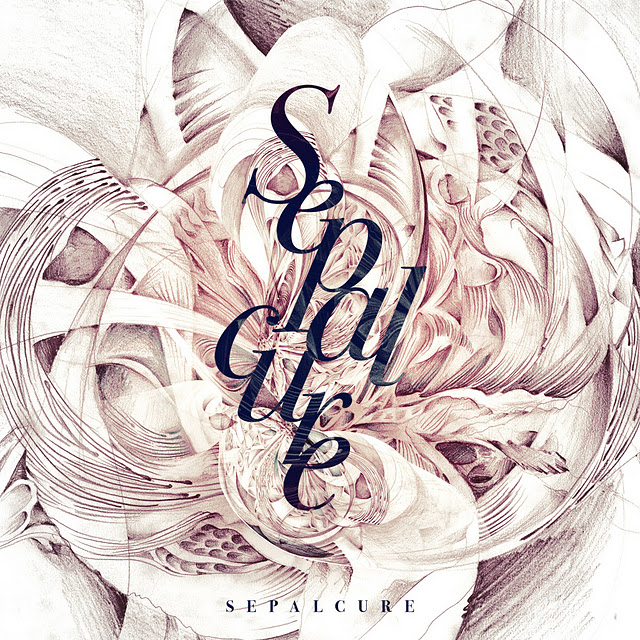I sometimes wonder what it would be like to abstain from all the albums and singles marked by bass music’s many mutations for a whole year and then around December go through the whole lot chronologically one by one. While I don’t think results would prove as linear as a marathon through your favorite AMC show or a binge on a few comic book arcs, I do think there could be an argument made for a singular thread running through the whole experience. Perhaps the thread is battered and frayed, but its center would still be clearly visible. Bass flies at a quick exponential pace and its only a matter of time that its current homogenized moniker “dubstep” will be labeled as such.
The point isn’t that Sepalcure’s eponymous full-length debut is just this week’s episode, but that it’s a perfect example of the pace and dynamic of bass’s singular growth from one artist to the next. The lifeblood of themes and motifs that pumps through the pallet of the genre’s best producers doesn’t seem so much a cutting and pasting of each others’ styles, or even indebted to the tangibility of “style” – Sepalcure certainly isn’t – but a result of a unconsciously collective drive toward some esoteric mountaintop. Of course that can be a stale dynamic for a scene as widespread as the whole planet even as it grows, but bass somehow straddles a few undefined lines that makes it work. Artists of the genre are often defined by elements as minute as snare sounds, yet their framework spans the pallet of multiple styles and multiple decades. Then there’s that almost-linearity I’m trying to get at. I might just be jumping the gun though. It would, admittedly, be much more interesting to marathon this whole thing when the show’s over, so to speak.
Immediately striking on Sepalcure is the grace and fluidity with which these songs are constructed. The album’s fifty-one minutes fly the hell by at a breakneck downhill pace and while each track is infinitely busy they never find themselves reaching or crowded. They don’t sit still either, exchanging drum patterns and hooks without stopping to look back. The atmosphere is undoubtedly indebted to dubstep’s penchant for expansive urban landscaping, but it maintains a more abstracted aura than, say, Burial or Scuba. The surroundings are temporal rather than geographical – often tied to 90s house, which means we get to see throbbing glacial organs and electric pianos more often than wobbling sawtooth synthesizers. “Me” opens with a liquidated synth melody and far off exhalations while a furious 2-step latches onto a deep thrumming bass and doesn’t let go. The weight of the diabolical organ hook isn’t really felt in full until it drops out near the middle only to return two-fold after the percussion has had its spotlight.
There’s a sort of unconsciousness to these songs that manage to understate how fleeting almost everything is about them. The hooks and vocal samples are textual without sacrificing their immediate shake-appeal. Melodies are stealthily deployed and don’t always hit until they’re at an ascending crescendo of sorts. The low-end is perhaps the culprit. A lot of the stuff on here toils near severe sub-octaves and doesn’t really become clear until the kick is left alone to just steamroll through the song. Unlike most of their piers, the duo build vocals around that low end instead of making them a song’s focal point, which accounts for moments like the beautifully throbbing sample near the end of “Breezin” coursing into the track out of the bass range. But there’s still a kind of balance between where the vinyl crackle coats those distant vocal moans and where the crowd-pleasing dynamics explode into view. Near the end of “Pencil Pimp,” after a bodiless, melodic grief-stricken mid-section writhing with mournful vocal samples, the low-end drops out and the overlapping melodies are peeled away before the kick returns, impacting things with a stark need-to-dance tangibility.
Sepalcure is also beautiful. The first three tracks sort of zoom by in a sweaty haze, but then “See Me Feel Me” happens and the record takes a turn. The track plays as though Balam Acab started to fuse his tear-stained vocal samples with club banger physicality. The warped vocal wavers up and down into emotional peaks and valleys while a chopped up noir-ish piano follows the staggering woodblock percussion and layers of half-lidded, post-rave synths furl and unfurl around a hyper-compressed kick. The track doesn’t truly impact until everything expands into widescreen at about the two minute mark, adding shimmering sample upon gorgeous shimmering sample.
That this debut from Sepalcure, a collaboration between American vets Praveen Sharma (Braille) and Travis Stewart (Machinedrum), was crafted in a two-week period might seem like quite the feat for such an accomplished and diverse release after only a few EPs, but it’s perhaps because of the time constraint that everything here rings with such confidence and drive and abandon. It’s also a telling measurement of bass music’s evolutionary scale. This is where we are now – bass’s many subsets and outliers (along with the pertinent outside influences) all fusing into a singular mixture of past, present, and future. With Travis Stewart moving away from glitch-hop, grabbing at Chicago footwork, and diving head first into UK bass (or at least accepting its influence wholeheartedly) on the stellar Room(s) released under his longtime Machinedrum moniker earlier this year, the New Yorker seems to be making a persuading, if not unexpected, play for dominance of a scene he doesn’t even seem to consider himself apart of. With Sharma’s steady hand in tow, Sepalcure might be all the additional argument we need.

